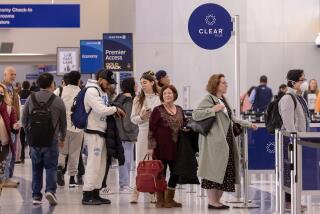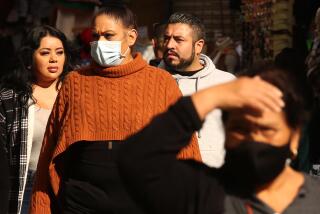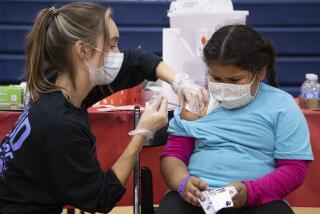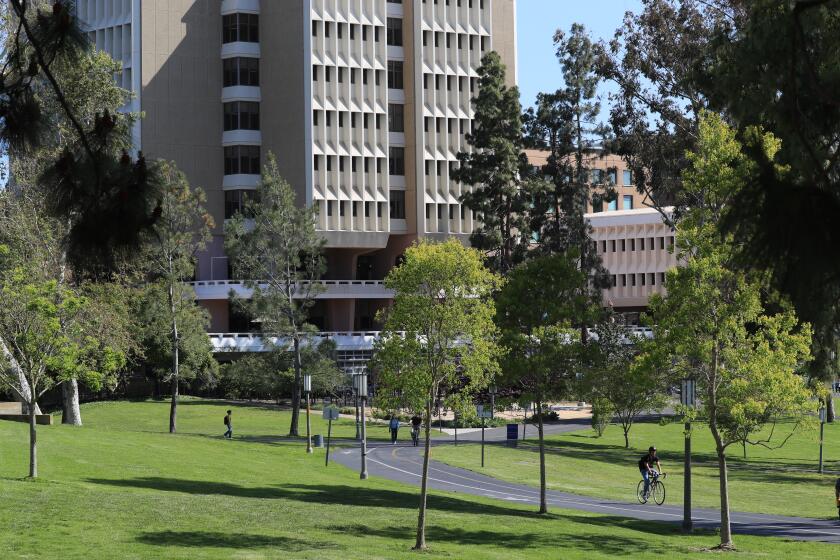California to require masks at school, a cautious decision that treats all students the same
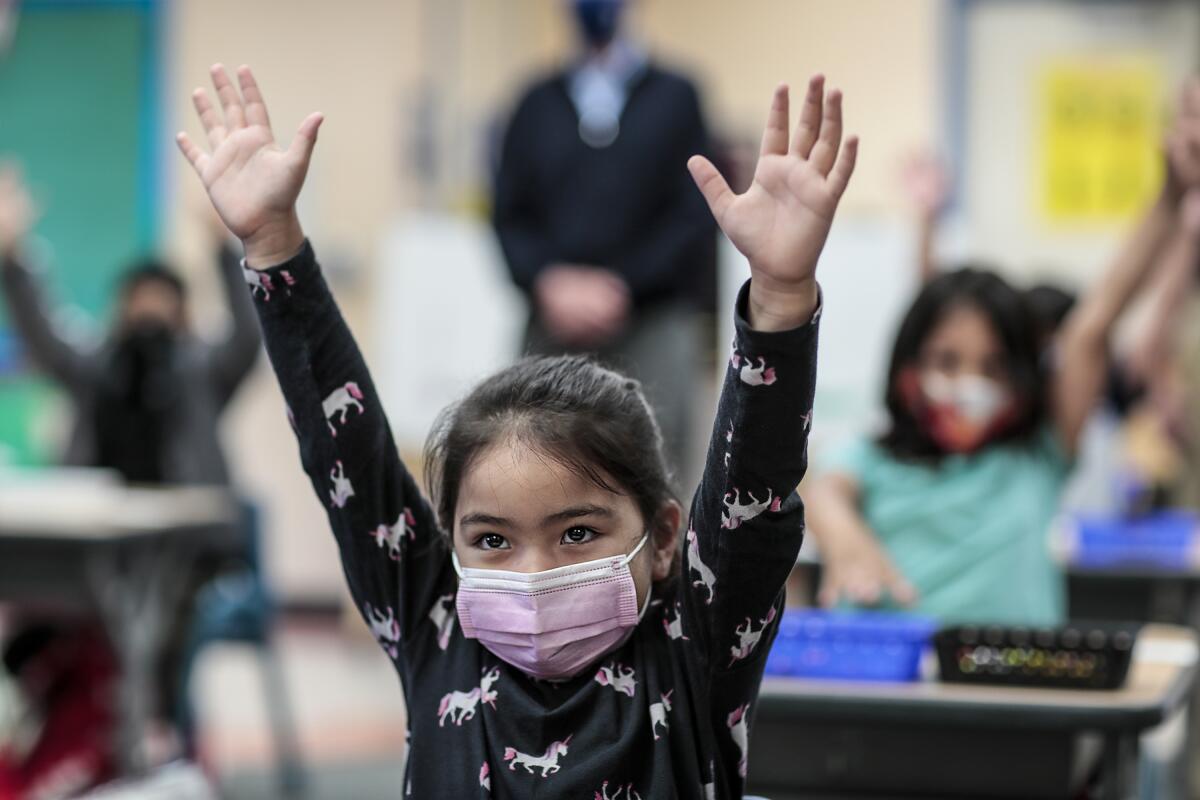
- Share via
The new school year in California will start with students and teachers wearing masks, state officials announced Friday, staking out a cautious position on a day when new federal guidelines stressed the importance of fully reopening schools and recommended masks only for those who are not vaccinated.
As part of a multilayered approach to limit the spread of COVID-19, those who are not vaccinated should wear masks indoors — and schools, health departments or states may continue to require masks on campus, the Centers for Disease Control and Prevention said.
California has opted for a safety standard that is likely to be more cautious than in many other states.
“We’re going to start with a requirement K through 12 that the year begins with masks,” said California Health and Human Services Secretary Mark Ghaly. “At the outset of the new year, students should be able to walk into school without worrying about whether they will feel different or singled out for being vaccinated or unvaccinated — treating all kids the same will support a calm and supportive school environment.”
He added: “And we think that’s very consistent with what the CDC outlined.”
The CDC guidelines also emphasized the importance of offering in-person learning to all after pandemic-forced school closures and online learning kept many children from campus, resulting in learning losses and mental health problems during months of isolation.
As an example to guide decision making, the CDC describes a situation in which not all students are vaccinated and physical distancing of three feet between desks is difficult to achieve. They advise that a school “should not exclude students from in-person learning to keep a minimum distance requirement,” the guidelines state.
When it comes to masks, the new federal guidelines also list situations in which authorities may appropriately maintain universal masking requirements — and some examples apply to California. They include a recent increase in the COVID-19 transmission rate, occurring in L.A. County and elsewhere. Overall infection rates remain far below what they were at the height of the winter surge.
L.A. County has urged all residents to wear masks indoors in public. Officials reported a doubling of new cases this week compared to last, with 1,107 reported Friday compared to 549 the previous Friday. There are 320 people hospitalized in the county for COVID-19; last Friday there were 280.
The CDC said that the wearing of masks should be considered when there is increasing community transmission of a COVID variant that spreads more easily — or makes people sicker. That could be the situation with the Delta variant, according to California health authorities.
Ghaly added that both the CDC and California recognize that various safety strategies work together in layers to make a school environment safer — with vaccination being foremost among them.
The fundamental shared goal, he added, is for all schools to open and for all students to have access to a safe, in-person classroom experience. In California, he said, masking is a central strategy toward achieving this objective.
The masking requirement also simplifies the work of school administrators who must determine how to create a safe environment through such strategies as improved ventilation and coronavirus testing, Ghaly said. Masks at least will be required for the start of the school year. After that, state guidelines will evolve based on science, data collection and prevalence of the virus and its more dangerous variants, he said.
For children with disabilities who cannot manage masks or who cannot wear masks safely, parents can seek an accommodation that includes not wearing a mask.
The CFT, which represents teachers and other school employees, strongly supported the mask requirement. Teachers monitoring hallways between classes should not have to police which students are allowed to forgo masks and which are not, said union President Jeff Freitas. A partial mandate could raise privacy issues and expose students to unwanted attention based on whether they were or were not wearing masks, he added.
Some of those same concerns were voiced by Megan Bacigalupi, who heads a group that advocated for reopening campuses as soon as possible. But for her, such concerns made the case that no one should be forced to wear a mask.
“In communities with high vaccine adoption and low hospitalization rates due to COVID, including most of California, masks should be optional for all students” as well as vaccinated staff, Bacigalupi said. “Continued mask mandates for vaccinated individuals undermines confidence in our highly effective COVID vaccines and may increase vaccine hesitancy, as the benefits from vaccination become less clear.”
California school districts are expected to fully reopen to the state’s 6 million K-12 students in the fall and the state budget approved by Gov. Gavin Newsom incorporates far-reaching multibillion-dollar education initiatives. These include funding for tutoring, after-school programs and additional counselors and teachers so that students can recover for lost time during the pandemic.
In the fall, many students at every grade level will start the school year unvaccinated. Those under 12 are not yet eligible for vaccinations. Many of those 12 and older have not received shots; they cannot be required to do so because the vaccines have not completed the full federal authorization process.
The new federal guidance is the latest revision in its advice for schools. In March, the CDC stopped recommending that children and their desks be spaced 6 feet apart, shrinking the distance to 3 feet, and dropped its call for use of plastic shields. The CDC still recommends at least 3 feet of distance when students are not vaccinated.
After facing legal action from a parents group, California dropped its distancing requirements altogether, although other health agencies and districts have the option to impose them.
In May, the CDC said that Americans in general don’t have to be as cautious about masks and distancing outdoors and that fully vaccinated people don’t need masks in most situations. That change was incorporated into updated guidance for summer camps — and now, schools.
American Federation of Teachers President Randi Weingarten praised the CDC guidelines as “grounded in both science and common sense.”
“The guidance confirms two truths: that students learn better in the classroom, and that vaccines remain our best bet to stop the spread of this virus and get our kids and educators fully back to those classrooms for in-person learning,” she said. “It also makes clear that masking is important in the absence of vaccination.”
Regardless of the mask policy at schools, passengers and drivers must wear a mask on school buses, including on buses operated by public and private school systems.
The CDC also advised that schools should provide masks to those students who need them, including on buses — and that no disciplinary action should be taken against a student who does not have a mask.
Moreover, fully vaccinated people who were in close contact with someone who has COVID-19 but do not have COVID-19 symptoms, no longer need to quarantine or be tested.
California is updating its own guidelines for schools and could issue those as early as next week.
More to Read
Sign up for Essential California
The most important California stories and recommendations in your inbox every morning.
You may occasionally receive promotional content from the Los Angeles Times.
